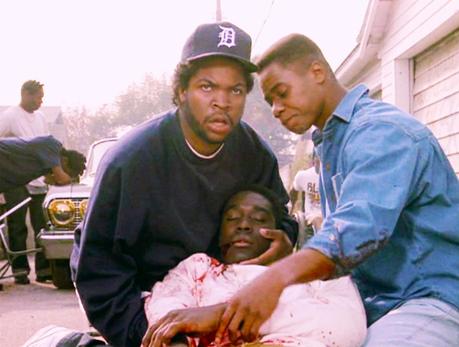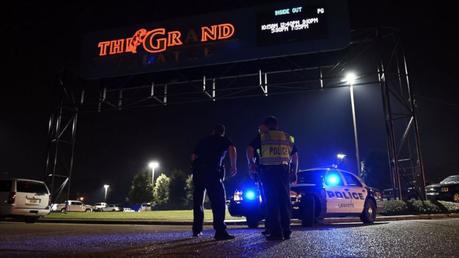I was sitting in a movie theater with my older brother and nephew when I got the email update from The Hollywood Reporter: “Three Dead After Shooting at Trainwreck Screening in Louisiana.” I was spooked. We were there waiting for Ant-Man to start, and what had just happened in Louisiana was nearly 1000 miles away. Still, I looked around to take stock of the mid-sized crowd on hand for a late Thursday night showing of a fun Marvel superhero movie, and I allowed the doubt to creep in. I didn’t know any of these people. How could I know for sure that one of them wasn’t a nutbar who would open fire at any given moment? After all, James Holmes looked like a normal Batman fan dressed up like the Joker at that midnight screening of Dark Knight Rises in Aurora, Colorado, and John Russell Houser looked like a perfectly average middle-aged man in Lafeyette, Louisiana. How could you tell that Holmes was crazy and Houser was an unbalanced misogynist who might have picked Trainwreck because of its pro-feminism stance?
Of course, the momentary legacy of such events is that they give you pause when you think about going into a dark room with a bunch of strangers to stare up at a big screen together for two hours. The individual communities (Aurora, Lafayette) feel the impact the most, and the lives lost will haunt the affected families forever. To the movie-loving general public, though, the movie theater is our church, and something like this feels like the violation of sacred ground.
What made the Louisiana event so startling is the odd, potentially purposeful timing of it. It comes nearly three years to the day after Aurora, Colorado. However, it was actually almost exactly 24 years ago that another movie set off violence, though this time it spread all over the country.
On July 14th, 1991, 23-year-old writer-director John Singleton debuted his masterpiece, Boyz N The Hood, a haunting story of young black men in the gang-plagued south-central section of Los Angeles. The final frame of the movie actually reads “Increase the Peace,” a plea to both the 800 gangs in LA at the time as well as the LAPD, who are depicted as an antagonizing force who pull people over due to racial profiling and needlessly harass them in the hopes of provoking them into an arrest.
So, of course gang violence erupted at theaters across the country on opening night.
Singleton shuffled around Los Angeles throughout opening night, sneaking into the back of movie theaters to take a glance at the audience the way directors sometimes like to do. Mere minutes after he left the Cineplex Odeon theaters in Universal City near downtown LA, gunfire erupted and five people were wounded. “The lights went down and the screen lit up and then it just went crazy. There was gunfire. I don’t know where exactly but real close. These guys were just chasing each other all over,” a 19-year-old moviegoer told The LA Times. “People were stampeding,” another moviegoer told The Associated Press, “People were running into the bathroom.”
There were reports of shootings at theaters near gang territories in Universal City, Upland and Chino as well as at theaters far away from gang territories, like San Francisco, Sacramento, Minneapolis, Riverdale, Ill., Tuscaloosa, Ala. and New Springfield, Mass. There were incidents at 20 of the 900 theaters showing the movie. For example, four people were arrested in Jersey City after a fight broke out in a shopping mall before a showing of the film, a 19-year-old man was stabled by two attackers while leaving a Chicago theater, and a shot was fired in a downtown Minneapolis theater, perhaps intentionally causing the ensuing riot which allowed shooters in a nearby car to open fire on pedestrians as they fled into the street. Four people were wounded, two critically. Across all incidents from LA to Seattle to Chicago to Minneapolis to Long Island, one man was fatally shot and 23 people were wounded.

The plot in Boyz N the Hood turns on a stunning drive-by shooting, and sadly that type of thing actually happened near theaters showing the movie
Looking back on it now, Frank Price, the chairman of Columbia Pictures who greenlit Boyz N The Hood, told The Atlantic the press might have been looking to turn the violence into a story, “If you had an incident within a mile of the theater, it was somehow connected to Boyz n the Hood. I think that tamped down the box office. There were some people who got the impression that it might be dangerous to go to the movie. Hard to get people to risk their lives to attend your movie, worthwhile as it may be.”
As with Aurora and Lafayette, the violence set off a re-examination of theater security. “Theater security is a factor that is negotiated between studios and exhibitors,” Deadline recently explained. “When a theater books a volatile movie that could trigger violence, studios in the past sometimes have shared on-site security costs with movie chains.” That’s how Columbia Pictures reacted to the Boyz N the Hood violence. Instead of pulling the movie from the theaters, they kicked in a little more to security costs, and ultimately backed their director when he told the press, “[The violence] is indicative of the degeneration of American society, not a reflection of my film, which is about family, love and friendship. I didn’t create the conditions under which people shoot each other. This happens because there’s a whole generation of people who are disenfranchised.” Singleton actually based the movie on his experiences growing up in south-central LA. “I won’t turn my back on my brothers. [I hope they don’t] turn their back on me. To withdraw the film would be an act of artistic racism.”

The scene in Lafayette last week
Of course, Aurora and Lafayette have also been linked to renewed calls for gun control laws. Boyz N the Hood was a little different. This wasn’t about the mentally unbalanced bringing guns to a theater. It was about one single movie bringing rival gangs to the same theater at the same time. As Steve Valdivia, a then-executive director of a Los Angeles agency that intervened in gang disputes, told the New York Times, “If every gang territory had its own movie house we would not have a problem. We knew that some gang members were deciding not only what clothes to wear but what armaments to take along. They prepare for the worst. The film just created a new venue. The movie itself has a good message. We reviewed it. It had nothing to do with the violence.”
We’re talking about early July 1991. Screenings of the Wesley Snipes movie New Jack City had similarly sparked violence around movie theaters earlier in the year. LA’s homicide rates had been soaring ever since the beginning of the crack cocaine epidemic in 1984. Rodney King had just been arrested at the end of March. That means the city was on the cusp of the Rodney King Riots in April 1992, which is when rioting went on for 6 days after a jury acquitted four police officers of using excessive force even though the public had all seen the videotape evidence of the cops beating King with their batons 56 times before ever attempting to cuff him. So, things were tense, to say the least. It was a time where if you went to see a movie like Boyz N the Hood you risked getting caught in-between a gang war.
Since then, the homicide rate in south-central LA has decreased by 75%. Territorial gang wars are presumably no longer a concern at movie theaters. Instead, we now run the risk, however miniscule, of being target practice for a madman who may simply shoot you for talking during the movie.
Source: Deadline, New York Times, LA Times, The Atlantic

